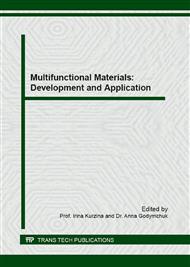[1]
J.A. De La Casa, E. Castro, Recycling of washed olive pomace ash for fired clay brick manufacturing, Constr. Build. Mater. 61 (2014) 320-326.
DOI: 10.1016/j.conbuildmat.2014.03.026
Google Scholar
[2]
G. Nirmala, G. Viruthagiri, FT-IR characterization of articulated ceramic bricks with wastes from ceramic industries, Spectrochim. Acta A. 126 (2014) 129-134.
DOI: 10.1016/j.saa.2014.01.143
Google Scholar
[3]
S. Khunton, S. Nilpairach, S. Sangsuk, Using lime mud waste from pulp mill as an additive in brick clay, Key Eng. Mat. 608 (2014) 3-7.
DOI: 10.4028/www.scientific.net/kem.608.3
Google Scholar
[4]
H.Y. Zhang, Analysis of macro-performance of FA ceramic brick, Adv. Mater. Res. 849 (2014) 279-282.
Google Scholar
[5]
E. Ferraz, J. Coroado, J. Gamelas, J. Silva, F. Rocha, A. Velosa, Spent brewery grains for improvement of thermal insulation of ceramic bricks, J. Mater. Civil Eng. 25 (2013) 1638-1646.
DOI: 10.1061/(asce)mt.1943-5533.0000729
Google Scholar
[6]
S. Donatello, C.R. Cheeseman, Recycling and recovery routes for incinerated sewage sludge ash (ISSA): A review, Waste Manage. 33 (2013) 2328-2340.
DOI: 10.1016/j.wasman.2013.05.024
Google Scholar
[7]
W. Acchar, J.E. Silva, A.M. Segadães, Increased added value reuse of construction waste in clay based building ceramics, Adv. Appl. Ceram. 112 (2013) 487-493.
DOI: 10.1179/1743676113y.0000000118
Google Scholar
[8]
B.B. Bobovich, V.V. Devyatkin, Production and consumption waste treatment, Intermet inziniring. in Russia. Moscow, (2000).
Google Scholar
[9]
E.G. Shchukina, R.R. Beple, N.V. Arkhincheeva, Mineral raw material and waste utilization in construction material production. Vestnik SGTU. in Russia. Ulan-Ude, (2004).
Google Scholar
[10]
A.V. Volzhenskii, I.A. Ivanov, B.N. Vinogradov, Ashes and clinkers in building material production, Stroyizdat Ed. in Russia. Moscow, (1984).
Google Scholar
[11]
I. Yu. Yur'ev, M.S. Trebina, Ceramic brick based on bottom ash waste, Proc. in Russia. 59th Sci. Conf., (2013) 519-521.
Google Scholar
[12]
G.I. Storozhenko, A. Yu. Stolboushkin, L.N. Tatski, A.I. Kazakov, E. Ya. Tsukanova, Comparative analysis of mold powder preparation for dry-press process of brick molding, Constr. Mat. in Russia. 4 (2008) 210-215.
Google Scholar
[13]
R.A. Nazirov, S.L. Rogacheva, Experimental study of natural radionuclide leaching during hydraulic high-lime ash removal, News High. Educ. Inst. Constr. 1 (2008) 82-85.
Google Scholar
[14]
N.K. Skripnikova, I. Yu. Yuriev, Bottom ash waste utilization in Tomsk region for production of different building materials, Vestnik TSUAB. in Russia. 2 (2013) 245-249.
Google Scholar
[15]
A.M. Salakhov, G.R. Tuktutarova, V.P. Building ceramics based on high-dispersity compositions, Constr. Mat. in Russia. 12 (2006) 244-245.
Google Scholar
[16]
Y. Xu, C. Yan, B. Xu, X. Ruan and Z. Wei, The use of urban river sediments as a primary raw material in the production of highly insulating brick, Ceram Int. 40 (2014) 8833-8840.
DOI: 10.1016/j.ceramint.2014.01.105
Google Scholar
[17]
A. K. Parashar and R. Parashar, Comparative study of compressive strength of bricks made with various materials to clay bricks, Int. J. Scien. Res. Publ. 7 (2012) 1-4.
Google Scholar
[18]
Skripnikova, N.K. I. Yu. Yuriev Ceramic products based on microdisperse bottom-ash compounds, Vestnik TSUAB. in Russia. 4 (2011) 128-131.
Google Scholar
[19]
I. Yu. Yuriev, N.K. Skripnikova, O.G. Modified bottom-ash waste affecting burned ceramic products, Vestnik TSUAB. in Russia. 4 (2013) 156-159.
Google Scholar


